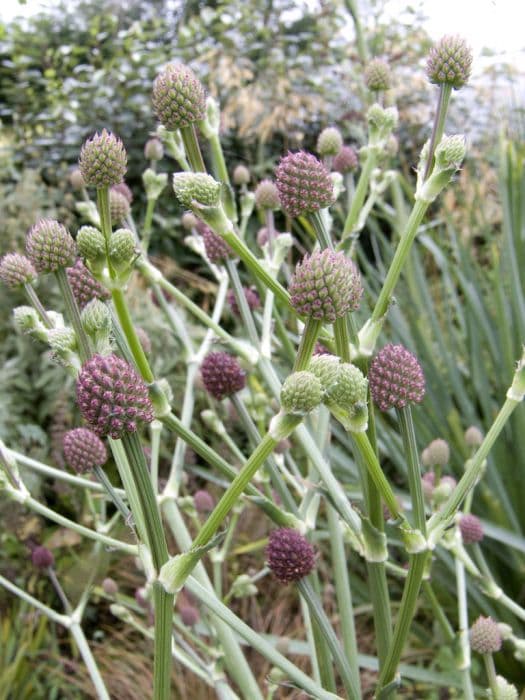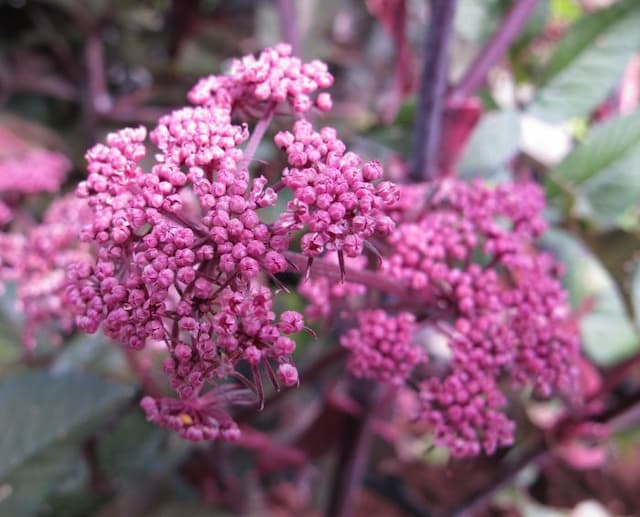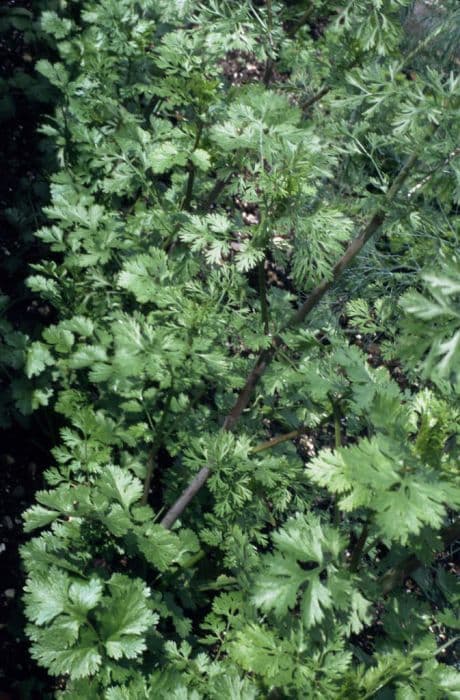Giant Sea Holly Eryngium pandanifolium

ABOUT
Eryngium pandanifolium, commonly known as Giant Rhubarb or Prickly Rhubarb, is a striking and architectural perennial plant. It has a robust, upright stance, and its foliage comprises a bold rosette of long, spiky leaves that resemble those of the Pandanus plants (hence the species name implying Pandanus-like leaves). The leaves are typically a rich, deep green and have impressively sharp edges with a strong, leathery texture. During its blooming period, Giant Rhubarb produces tall, branching stems that are topped with cone-like flower heads. These flowers are small, compact and are often surrounded by a ruff of spiny bracts, which can vary in color from green to silvery-blue, adding to the plant's unique appearance. The overall impression of Eryngium pandanifolium is one of rugged beauty and distinctive, almost prehistoric, character. Its visual appeal is further enhanced by the contrast between its formidable leaves and the delicate, yet prominently displayed, flower heads.
About this plant
 Names
NamesFamily
Apiaceae
Synonyms
Giant Rhubarb, False Water Hemlock
Common names
Eryngium pandanifolium
 Toxicity
ToxicityTo humans
Eryngium pandanifolium, commonly known as giant sea holly, is not widely recognized as a toxic plant to humans. There is limited information available on its toxicity, and it does not appear in major lists of poisonous plants. However, as with any plant, individual allergic reactions or sensitivities can occur. It's always recommended to exercise caution and avoid ingesting any plant parts without proper knowledge of its edibility and effects.
To pets
Giant sea holly is not widely cited as a toxic plant to pets either. There is a scarcity of specific information regarding its toxicity to animals such as dogs and cats. However, it's always prudent to prevent pets from ingesting plants not meant for consumption, as they can cause gastrointestinal upset or other issues due to individual sensitivities or non-toxicity related problems such as obstruction. If you suspect your pet has ingested giant sea holly and is showing signs of distress, it's best to contact a veterinarian.
 Characteristics
CharacteristicsLife cycle
Perennials
Foliage type
Evergreen
Color of leaves
Green
Flower color
Green
Height
5-6 feet (1.5-1.8 meters)
Spread
1-2 feet (0.3-0.6 meters)
Plant type
Herb
Hardiness zones
8
Native area
South America
Benefits
 General Benefits
General Benefits- Low Maintenance: Eryngium pandanifolium, commonly known as giant sea holly, requires minimal care once established, making it suitable for gardeners seeking low-maintenance plants.
- Drought Tolerant: Giant sea holly is highly drought-resistant, making it an excellent choice for xeriscaping and arid climate gardens.
- Attracts Pollinators: The flowers of the giant sea holly attract bees, butterflies, and other pollinating insects, supporting biodiversity.
- Architectural Interest: With its striking appearance, tall structure, and unique foliage, giant sea holly adds an architectural element to garden designs.
- Long-Lasting Blooms: The plant features long-lasting flowers that are ideal for cut flower arrangements and can add interest to the garden throughout the season.
- Deer Resistant: Eryngium pandanifolium is known for being resistant to deer, which can be beneficial for gardens in areas where deer predation is a problem.
- Soil Adaptability: Giant sea holly can adapt to a range of soil conditions, though it prefers well-drained soils.
 Medical Properties
Medical Properties- This plant is not used for medical purposes.
 Air-purifying Qualities
Air-purifying QualitiesThis plant is not specifically known for air purifying qualities.
 Other Uses
Other Uses- Eryngium pandanifolium, commonly known as Giant Sea Holly, can be used as a striking architectural plant in garden design, adding texture and interest with its spiky leaves and stems.
- In floral arrangements, both fresh and dried, the metallic blue flower heads and unique foliage of Giant Sea Holly create an exotic and lasting display.
- The plant's robust stems can be used as natural skewers for grilling, imparting a subtle and distinctive flavor to meats and vegetables.
- Giant Sea Holly serves as a host for beneficial insects, attracting predators like ladybugs and lacewings that help control garden pests.
- Due to its distinctive form, Eryngium pandanifolium is utilized in landscape art and photography to provide structure and visual appeal in compositions.
- The rugged texture of the plant is sometimes replicated in metalwork and sculptural pieces for garden art and ornamentation.
- Giant Sea Holly can play a role in xeriscaping, a landscape design that requires minimal irrigation, due to its drought-tolerant characteristics.
- Crafters use the unique seed heads and stems in the creation of natural jewelry, like pendants and earrings, after preserving and treating them.
- In certain cultures, the root of the Eryngium pandanifolium is used as a flavoring agent for drinks and food, imparting a distinctive taste.
- The plant functions as a protective barrier due to its spiny leaves and can be planted to deter small animals and pedestrians from entering certain areas.
Interesting Facts
 Feng Shui
Feng ShuiGiant Sea Holly is not used in Feng Shui practice.
 Zodiac Sign Compitability
Zodiac Sign CompitabilityGiant Sea Holly is not used in astrology practice.
 Plant Symbolism
Plant Symbolism- Determination: Giant Sea Holly (Eryngium pandanifolium), with its spiky appearance and resilience, is often associated with determination, reflecting the plant's ability to thrive in challenging environments.
- Protection: The prickly texture and tough nature of the plant give it a symbolic meaning of protection, suggesting that it can serve as a shield against harm or negativity.
- Independence: This plant's ability to stand alone and maintain its distinctiveness without much help implies a strong sense of independence and self-reliance.
- Attraction: Despite its thorny demeanor, the Giant Sea Holly is known for attracting butterflies and bees, symbolizing an allure that goes beyond the superficial and touches the essence of true attraction.
- Unique Beauty: The unique appearance of the Giant Sea Holly, with its striking blue or metallic-colored flowers and architectural structure, celebrates the beauty that lies in being different and standing out from the rest.
 Water
WaterGiant Sea Holly should be watered deeply but infrequently, allowing the soil to dry out between waterings. A good rule of thumb is to water this drought-tolerant plant once every 7 to 10 days, providing about 1 to 1.5 gallons of water per plant each time during the active growing season. During the winter, when the plant is dormant, reduce watering to once a month, or even less if the plant is in extremely cold conditions. Adjust the watering schedule based on weather conditions; less water is required during rainy periods or in cooler temperatures.
 Light
LightGiant Sea Holly thrives best in full sun conditions, receiving at least 6 hours of direct sunlight daily. The ideal spot for planting Giant Sea Holly is a location where it is exposed to unfiltered sunshine for most of the day. Avoid heavily shaded areas, as insufficient light can hamper the plant's growth and reduce flowering.
 Temperature
TemperatureGiant Sea Holly is hardy in a wide range of temperatures and can survive in temperatures as low as 0 degrees Fahrenheit and as high as 90 degrees Fahrenheit. The ideal temperature for encouraging growth and flowering is between 60 and 80 degrees Fahrenheit. This plant is well-suited for gardens in areas with a temperate climate and can handle occasional temperature fluctuations outside this range with little impact.
 Pruning
PruningPruning Giant Sea Holly is primarily for aesthetic purposes and to remove spent flower stalks, which can be done after flowering in late summer or fall. Pruning will encourage new growth and can help maintain a tidy shape. Annually, during early spring, remove any dead or damaged foliage to promote healthy growth. Pruning is not frequently required, but monitoring the plant's appearance and trimming as needed will keep it looking its best.
 Cleaning
CleaningAs needed
 Soil
SoilGiant rhubarb needs well-draining soil with a mix of sand, peat, and loam, maintaining a soil pH between 5.5 and 7.5.
 Repotting
RepottingGiant rhubarb should be repotted every 2 to 3 years to refresh soil and accommodate root growth.
 Humidity & Misting
Humidity & MistingGiant rhubarb thrives best at moderate humidity levels but is quite adaptable to different humidity conditions.
 Suitable locations
Suitable locationsIndoor
Provide full sun, well-draining soil, and space for growth.
Outdoor
Plant in full sun, ensure soil drainage, protect from strong winds.
Hardiness zone
8-11 USDA.
 Life cycle
Life cycleCommonly known as Giant Sea Holly, Eryngium pandanifolium begins its life cycle as a seed, which after dispersal germinates in suitable conditions – typically well-drained and not too rich soil. The seedling develops a deep taproot and a rosette of spiky, pandanus-like leaves, which allows it to withstand periods of drought. As the plant matures, it develops a sturdy stem and in summer, it produces a tall inflorescence with cone-shaped flower heads surrounded by spiny bracts, which are often metallic blue or green. Pollination is typically carried out by a variety of insects attracted to the flowers. After fertilization, seeds are produced and dispersed, ready to begin the next generation. Over time, Eryngium pandanifolium forms large clumps and can live for several years, being a herbaceous perennial plant.
 Propogation
PropogationPropogation time
Spring-Early Summer
Propogation: Eryngium pandanifolium, commonly known as the Giant Sea Holly, is most commonly propagated through seed. To propagate, seeds should be sown in late winter to early spring under glass in a cold frame or greenhouse at temperatures around 55-64°F (13-18°C). They can take several weeks to germinate. Once the seedlings have developed, they should be potted on and grown in cooler conditions until they are ready to be planted out in the summer. It is important to maintain good moisture levels without overwatering, as Giant Sea Holly prefers well-drained soil.








